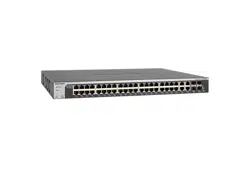Loading ...
Loading ...
Loading ...

Manage Device Security
260
ProSAFE 10-Gigabit Smart Managed Switch XS728T and XS748T User Manual
The following table describes the fields on the Client Summary page.
Set Up Traffic Control
You can configure storm control, port security, protected port, and private VLAN settings.
From the Security > Management Security > Traffic Control menu, you can access the
pages that are described in the following sections:
• Configure Storm Control on page 260
• Configure Port Security on page 262
• Configure Protected Ports on page 265
• Configure Private VLANs on page 266
Configure Storm Control
A broadcast storm is the result of an excessive number of broadcast messages
simultaneously transmitted across a network by a single port. Forwarded message
responses can overload network resources, cause the network to time out, or do both.
The switch measures the incoming packet rate per port for broadcast, multicast, unknown,
and unicast packets and discards packets if the rate exceeds the defined value. You enable
storm control per interface, by defining the packet type and the rate at which the packets are
transmitted.
Storm control is configured as a percent of the maximum port speed, which is 10 Gbps for all
ports.
To configure storm control settings:
1. Connect your computer to the same network as the switch.
You can use a WiFi or wired connection to connect your computer to the network, or
connect directly to a switch that is off-network using an Ethernet cable.
2. Launch a web browser.
3. In the address field of your web browser, enter the IP address of the switch.
Table 57. Client Summary information
Field Description
Port The port to be displayed.
User Name The user name representing the identity of the supplicant device.
Supplicant Mac Address The supplicant’s device MAC address.
Session Time The time since the supplicant logged in seconds.
VLAN ID The VLAN ID assigned by the authenticator to the supplicant device.
Loading ...
Loading ...
Loading ...
